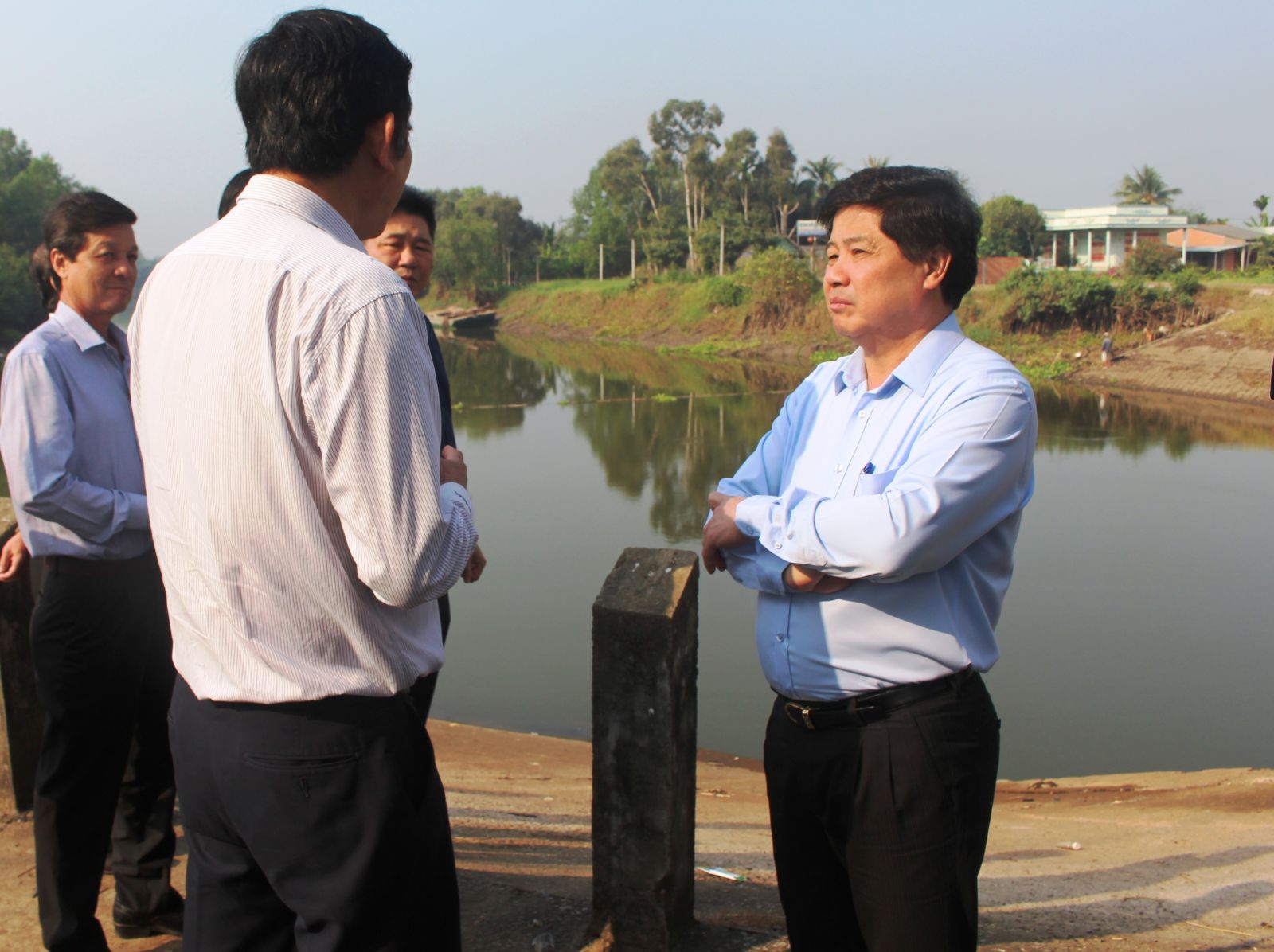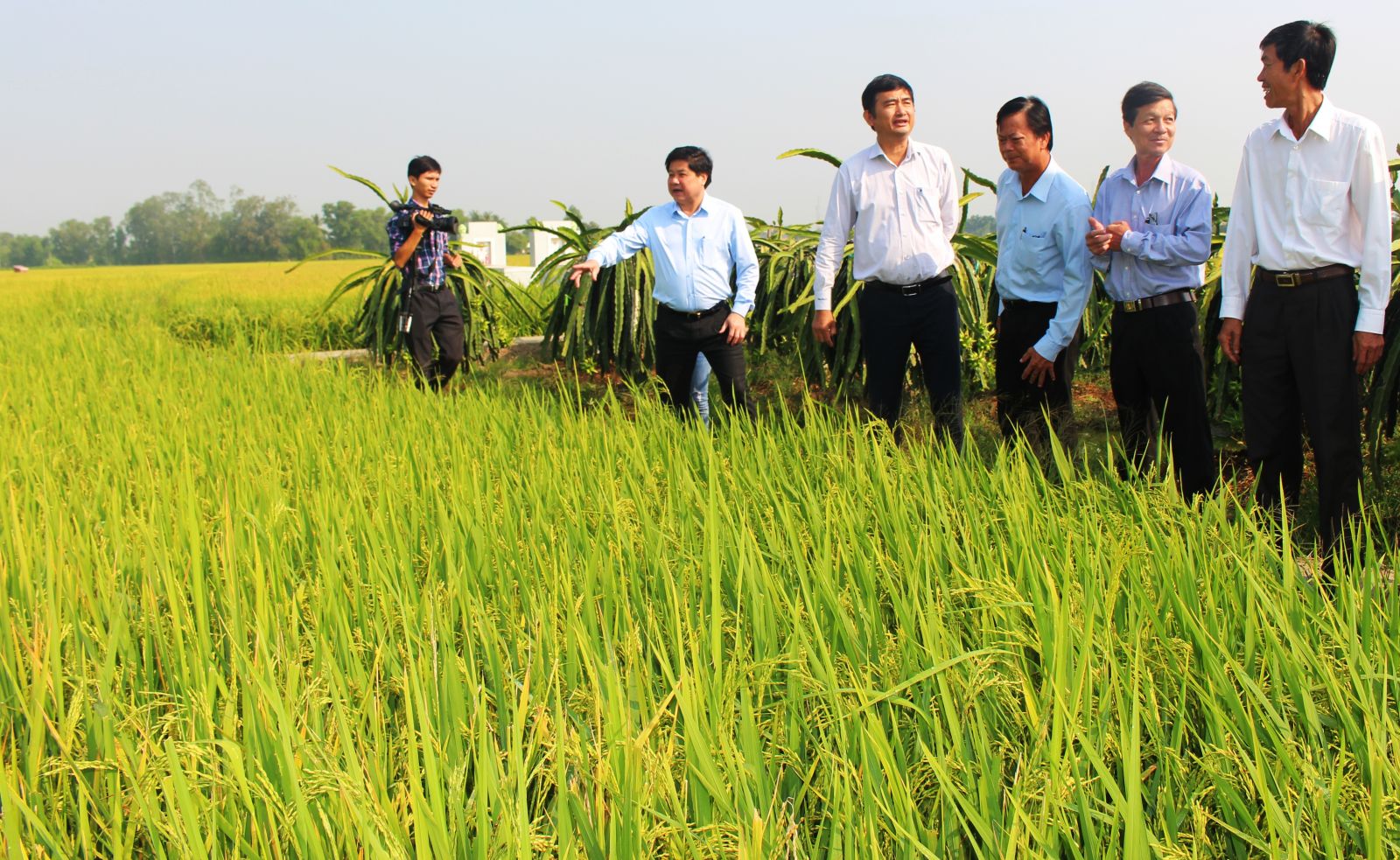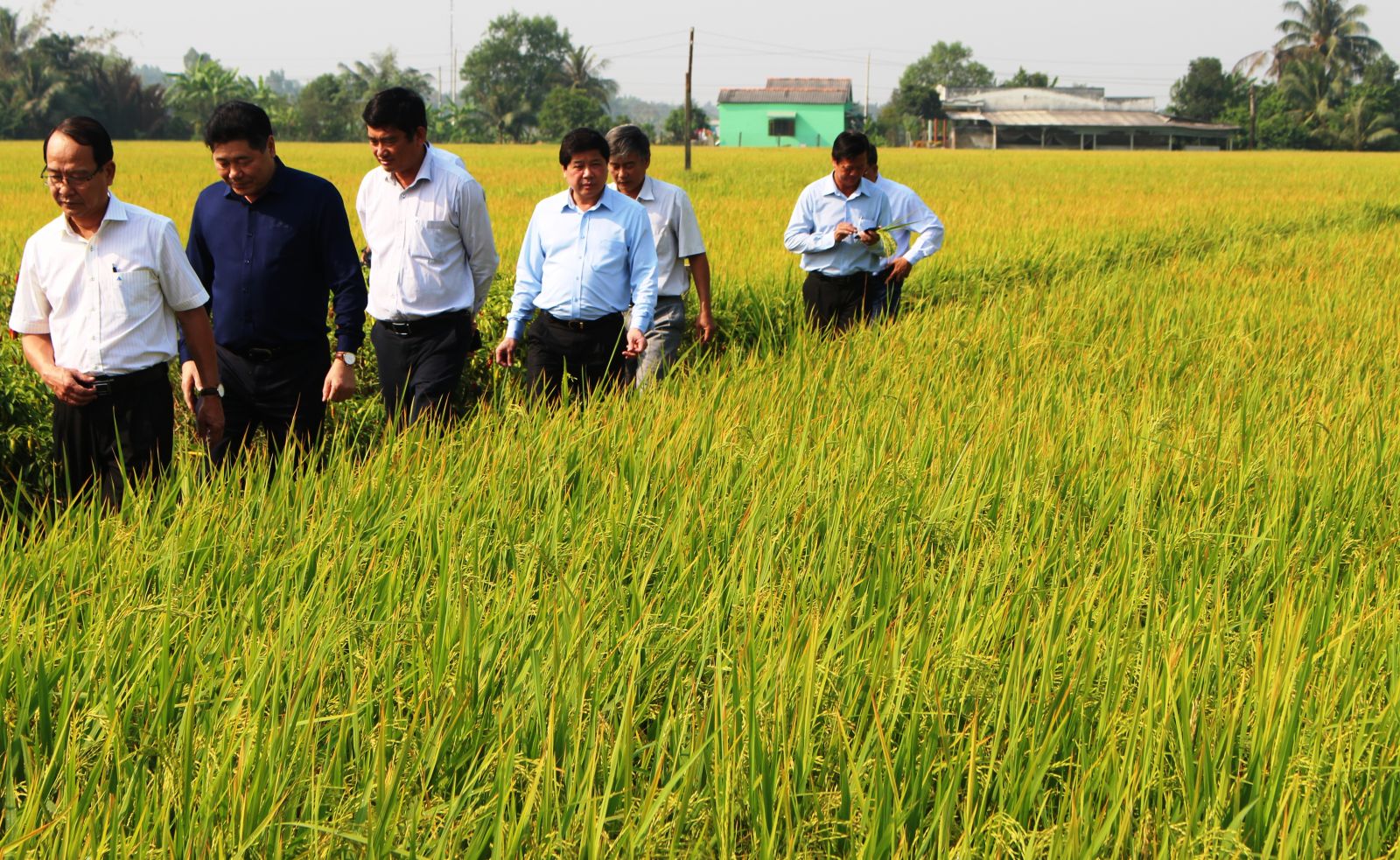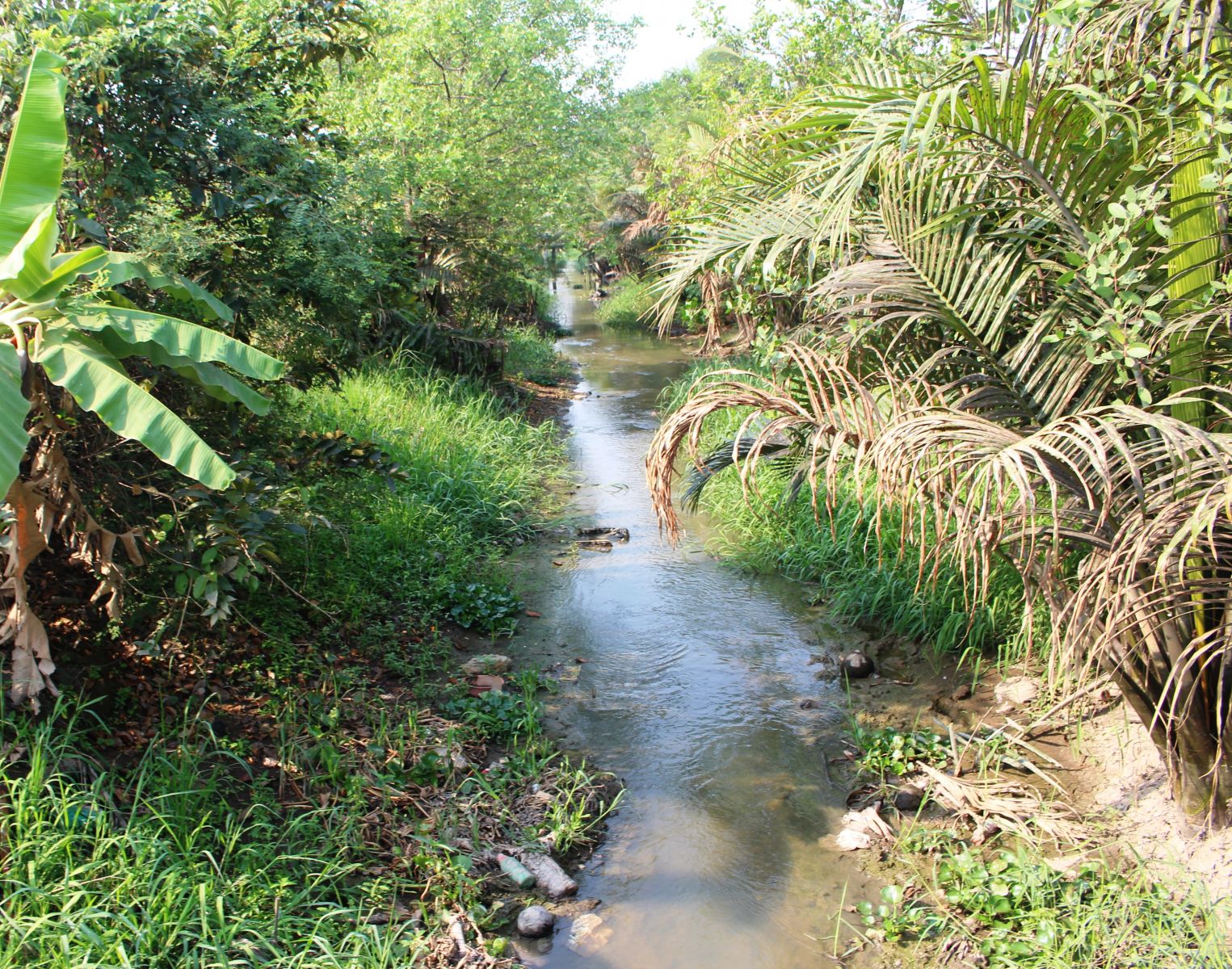
Deputy Minister of Agriculture and Rural Development - Le Quoc Doanh highly appreciated the initiative in preventing and fighting against drought and salinity in Long An
Well response
According to the evaluation of Deputy Minister of Agriculture and Rural Development - Le Quoc Doanh, this year, the salinity level was more serious than in 2016, but thanks to the Ministry's general guidance, localities proposed many solutions to take initiative in coping very early so its damage is virtually minimized.
According to a survey in a rice field in Tan Tru district, Long An province, Deputy Minister - Le Quoc Doanh said: "In fact, local people are very active in the production of coping with drought and salinity; store and pump fresh water for production in winter-spring crop; many solutions to conserve water and keep moisture for crops such as dragon fruits are very effective in the current drought and salinity conditions”.
In addition, the Deputy Minister said that not only Long An in general, but also in the current Mekong River Delta region, almost all areas of Winter-Spring rice are free from the effects of drought and saline intrusion. At present, the whole region has harvested over 700,000 hectares of Winter-Spring rice, it is expected to harvest over 1 million hectares by the end of February; with good productivity, higher than the average of about 1-2 kg per hectare. For crops and fruit trees, local farmers have actively proposed solutions to limit salinity intrusion and actively store water.

According to Deputy Minister of Agriculture and Rural Development - Le Quoc Doanh, the Winter-Spring rice crop 2019-2020 escapes from the effects of drought and salinity intrusion
At the survey, Deputy Director of Long An Department of Agriculture and Rural Development - Nguyen Chi Thien said: “At present, the saline intrusion has been 140 km deep in the sea mouth. By forecasting the central branches, under the guidance of the Ministry of Agriculture and Rural Development, Long An province proactively proposes to mobilize farmers to sow early to avoid drought and salinity. Currently, the Winter-Spring crop of 2019 - 2020 is over 226,000 hectares, of which about 6,000 hectares in the lower areas are affected by drought and salinity. However, in recent years, the localities overcoming water sources have firstly ensured that about 4,000 hectares of rice will not be affected; about 2,000 hectares more affected productivity and output. If we compare the effects of drought and salinity damage in 2016 (over 100 billion VND), this year, the damage is much less; Up to now, no rice area has been completely damaged.

The mission of Ministry of Agriculture and Rural Development surveys rice fields in Tan Tru district, Long An province
Being the locality most affected by drought and salinity, Vice Chairman of Tan Tru District People's Committee - Trinh Phuoc Trung said: “The whole district has about 4,500 hectares of Winter-Spring rice crop 2019-2020. However, nearly 2,000 hectares are likely to be affected by drought and salinity intrusion, of which, about 1,700 hectares are affected to reduce productivity and quality by 30-70 percent. The reason is that the majority of people do not follow local sowing recommendations”.
Mr. Nguyen Van Ta, living in Binh Lang commune, Tan Tru district, said: “I have nearly 0.4 hectares of Winter-Spring rice about 10 days to harvest. Due to the local recommendations, I actively store water in the field for this crop, it ensures rice to develop well. Currently, around a lot of areas in the field of the shortage of water, the locality is actively implementing many solutions to save rice for our farmers.

The channels and canals in Tan Tru district have very little water
Many solutions were deployed
In the face of drought and salinity intrusion, Long An province has directed branches and localities and implemented many solutions. Specifically, localities regularly measure and monitor changes in water quality, saline intrusion on main axis rivers and canals in the field; continuously updating information, forecasts and warnings of specialized agencies such as the Southern Meteorological and Hydrometeorological Station and the Southern Institute of Water Resources Research; promptly notify and warn on the mass media and on the province's website on natural disaster prevention and control so that the authorities, localities and people in the province know and take initiative in timely implementing measures to prevent and combat drought, water shortage and salinity intrusion to ensure sufficient supply of water for agricultural production and people's daily life.
Checking, reviewing, zoning areas where drought, water shortages and saltwater intrusion often occur in order to dredge, build temporary dams, install field pumping stations to timely supply water, store water for production. To set up temporary pumping stations at the key sluice gates (aqueducts of Chau Phe, Ong Sen, Ba Pho and Thu Thua canal) to pump water into the fields when the salinity decreases, ensuring service for agricultural production and daily life. The crucial embankments and key culverts are checked to promptly detect incidents and repair, promptly overcome salt water leaking into the interior fields, affecting the quality of water sources.
Coordinating with Dau Tieng - Phuoc Hoa Irrigation Exploitation Company Limited to supply, supplement and increase the amount of fresh water discharged to Vam Co Dong river when salinity rises to promptly push salt and take advantage of fresh water to serve the production. The southern regions which do not guarantee the fresh water source are not allowed to sow the crop. The crucial embankments which are reviewed, renovated and elevated are leaked, low embankments and temporarily are dammed to store water and prevent salinity in Ben Luc, Thu Thua, Thanh Hoa, Duc Hoa and Duc Hue districts. The main culverts are checked and covered canvas against leakage of saline water into the interior field. The system of canals and ditches is dredged to make the water flows clear.
|
On Vam Co Dong river: Salinity of 1.0 gram per liter to An Ha bridge, Duc Hoa district, about 88 kilometers from Soai Rap estuary; Salinity of 4.0 grams per liter to Rach Chanh sluice, Thu Thua district, about 55 kilometers from Soai Rap river.
On Vam Co Tay river: Salinity of 1.0 gram per liter to La Khoa bridge, Thanh Hoa district, about 92 kilometers from Soai Rap estuary; Salinity of 4.0 grams per liter to Binh Tam sluice, Tan An City, about 66 kilometers from Soai Rap River./.
|
By Huynh Phong Translated by Duc Tam
Source: http://baolongan.vn/thu-truong-bo-nn-ptnn-le-quoc-doanh-lua-dong-xuan-2019-2020-thoat-khoi-anh-huong-cua-han-man-a90666.html
 Central bank mulls raising gold position limit for lenders
Central bank mulls raising gold position limit for lenders






